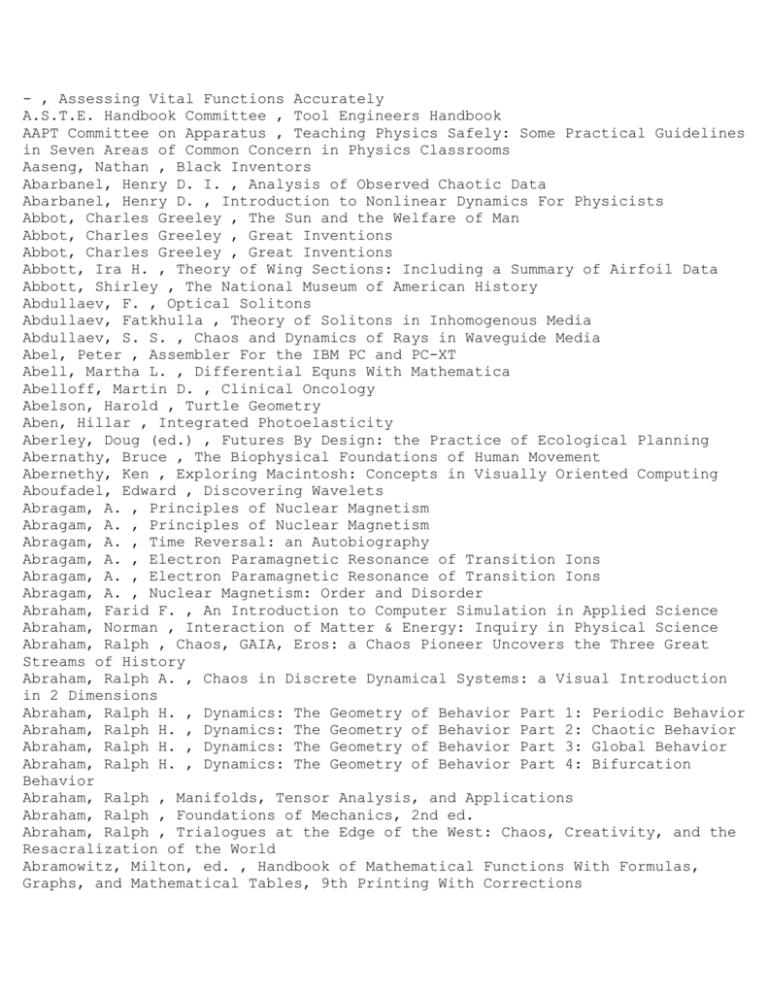Sample Questions Special Theory Relativity - Mark Elmer Dolan ...
PhysicsSpecial Theory of Relativity Sample QuestionsQuestion 1A spaceship takes a nonstop journey to a planet and returns in 10 hours according to a clock on the spaceship. If the speed of the spaceship is 0.80c, how much time has elapsed on the Earth? (PageRef: Sec. 26.4-26.5)17 hQuestion 2A spaceship moves away from the Earth with a speed of 0.80c. The spaceship then fires a missile with a speed of 0.50c relative to the spaceship. What is the velocity of the missile measured by observers on the Earth if the missile is fired toward the Earth? (PageRef: Sec. 26.10)0.50cQuestion 3The closest star to our solar system is Alpha Centauri, which is 4.30 light years away. A spaceship with a constant speed of 0.800c relative to the Earth travels toward the star. How much time would elapse on a clock on board the spaceship?3.23 yQuestion 4How many joules of energy are required to accelerate one kilogram of mass from rest to a velocity of 0.866 c? (PageRef: Sec. 26.4-26.9)9.0 × 10^16 J Question 5How much energy would be released if 2.0 kg of material was lost during a reaction? (PageRef: Sec. 26.4-26.9)1.8 × 10^17 JQuestion 6The closest star to our solar system is Alpha Centauri, which is 4.30 light years away. A spaceship with a constant speed of 0.800c relative to the Earth travels toward the star. How much time would elapse on a clock on the Earth?5.38 yQuestion 7The kinetic energy of a proton is 80% of its total energy. What is the speed of the proton? (PageRef: Sec. 26.4-26.9)0.87c Question 8Two spaceships are traveling through space at 0.60 c relative to the Earth. If the ships are headed directly toward each other, what is their approach velocity, as measured by a person on either craft? (PageRef: Sec. 26.10)none of the given answersQuestion 9Consider two spaceships, each traveling at 0.50c in a straight line. Ship A is moving directly away from the Sun and ship B is approaching the Sun. The science officers on each ship measure the velocity of light coming from the Sun. What do they measure for this velocity? (PageRef: Sec. 26.10)On both ships it is measured to be exactly c.Question 10A fast spaceship is traveling with a speed of 0.80c. How fast would light travel from the headlights of the ship relative to a stationary observer? (PageRef: Sec. 26.10)1.0cQuestion 11The closest star to our solar system is Alpha Centauri, which is 4.30 light years away. A spaceship with a constant speed of 0.800c relative to the Earth travels toward the star. What distance does the space ship travel according to a passenger on the ship? (PageRef: Sec. 26.4-26.5)4.30 lyQuestion 12The length of a spaceship is 10 m when it is at rest. If the spaceship travels by you with a speed of 0.70c, what length does it appear to you? (PageRef: Sec. 26.4-26.5)7.1 mQuestion 13How fast should a moving clock travel if it is to be observed by a stationary observer as running at one-half its normal rate? (PageRef: Sec. 26.4-26.5)0.87cQuestion 14The atomic bomb that was dropped on Nagasaki in 1945 killed 140,000 people, helping to end World War II on the next day. It released energy equivalent to that of 20,000 tons of TNT explosive. How much mass was converted to energy when this took place? (1000 tons of TNT = 4.3 × 10^12 J) Incidentally, modern H-bombs have energy yields 1000 times as much. (PageRef: Sec. 26.4-26.9)1 gQuestion 15As the velocity of your spaceship increases, you would observe (PageRef: Sec. 26.4-26.9)none of the given answersQuestion 16In a nuclear plant, 10^17 J of energy is available from mass conversion. How much mass was lost? (PageRef: Sec. 26.4-26.9)1 kgQuestion 17How fast would a rocket ship have to move to contract to half of its proper length (as observed by a stationary object)? (PageRef: Sec. 26.4-26.5) 0.87c Question 18A spear is thrown by you at a very high speed. As it passes, you measure its length at one-half its normal length. From this measurement, you conclude that the moving spear's mass must be (PageRef: Sec. 26.7) twice its rest mass.Question 19As the speed of a particle approaches the speed of light, the momentum of the particle (PageRef: Sec. 26.7)increases.Question 20One 20-year-old twin brother takes a space trip with a speed of 0.80c for 30 years according to a clock on the spaceship. Upon returning to the Earth, what is his own age and the age of the Earth-based twin brother? (PageRef: Sec. 26.4-26.5)20; 3030; 5050; 7070; 90Mark Elmer DolanTemple University CS StudentPhiladelphia, PA 19130markymark233@gmail.com

-
Latest
 phrases - “Sir,' I said to the universe, 'I exist.' 'That ...
phrases - “Sir,' I said to the universe, 'I exist.' 'That ...This answer focuses exclusively on the widespread attribution of the "'Sir,' I said to the universe, 'I exist'" quotation to Douglas Adams. I recognize that this issue is tangential to the OP's questi...
-
Next
 The Dilemna Dilemma. | Grasping for Objectivity
The Dilemna Dilemma. | Grasping for ObjectivityI hated English in school, and I don’t expect that my blog follows the rules of the AP Stylebook – like, ever. I have endless grammar quirks that I am positive make my journalist friends secretly desp...
Popular Articles
- Rocket Power (TV Series 1999–2004) - Rocket Power (TV Series ...
- technique - What is the definition of 'playing in the pocket ...
- "Pocket rockets," in poker Crossword Clue Answers, Crossword ...
- 5 Sex Toys Every Man Should Own, Use & Use Again - LA Weekly
- Pocket Holsters: 11 Options For Easy Everyday Carry (2021 ...
- What is Elton John's most successful song? (Celebrity Exclusive)
